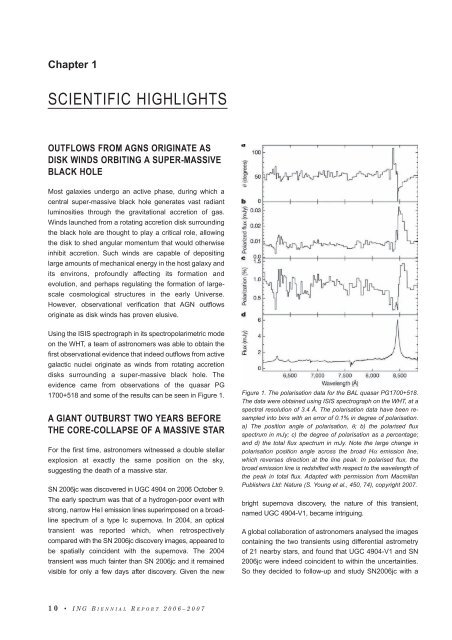PDF (6M) - Isaac Newton Group of Telescopes - Instituto de ...
PDF (6M) - Isaac Newton Group of Telescopes - Instituto de ...
PDF (6M) - Isaac Newton Group of Telescopes - Instituto de ...
You also want an ePaper? Increase the reach of your titles
YUMPU automatically turns print PDFs into web optimized ePapers that Google loves.
Chapter 1<br />
SCIENTIFIC HIGHLIGHTS<br />
OUTFLOWS FROM AGNS ORIGINATE AS<br />
DISK WINDS ORBITING A SUPER-MASSIVE<br />
BLACK HOLE<br />
Most galaxies un<strong>de</strong>rgo an active phase, during which a<br />
central super-massive black hole generates vast radiant<br />
luminosities through the gravitational accretion <strong>of</strong> gas.<br />
Winds launched from a rotating accretion disk surrounding<br />
the black hole are thought to play a critical role, allowing<br />
the disk to shed angular momentum that would otherwise<br />
inhibit accretion. Such winds are capable <strong>of</strong> <strong>de</strong>positing<br />
large amounts <strong>of</strong> mechanical energy in the host galaxy and<br />
its environs, pr<strong>of</strong>oundly affecting its formation and<br />
evolution, and perhaps regulating the formation <strong>of</strong> largescale<br />
cosmological structures in the early Universe.<br />
However, observational verification that AGN outflows<br />
originate as disk winds has proven elusive.<br />
Using the ISIS spectrograph in its spectropolarimetric mo<strong>de</strong><br />
on the WHT, a team <strong>of</strong> astronomers was able to obtain the<br />
first observational evi<strong>de</strong>nce that in<strong>de</strong>ed outflows from active<br />
galactic nuclei originate as winds from rotating accretion<br />
disks surrounding a super-massive black hole. The<br />
evi<strong>de</strong>nce came from observations <strong>of</strong> the quasar PG<br />
1700+518 and some <strong>of</strong> the results can be seen in Figure 1.<br />
A GIANT OUTBURST TWO YEARS BEFORE<br />
THE CORE-COLLAPSE OF A MASSIVE STAR<br />
For the first time, astronomers witnessed a double stellar<br />
explosion at exactly the same position on the sky,<br />
suggesting the <strong>de</strong>ath <strong>of</strong> a massive star.<br />
SN 2006jc was discovered in UGC 4904 on 2006 October 9.<br />
The early spectrum was that <strong>of</strong> a hydrogen-poor event with<br />
strong, narrow HeI emission lines superimposed on a broadline<br />
spectrum <strong>of</strong> a type Ic supernova. In 2004, an optical<br />
transient was reported which, when retrospectively<br />
compared with the SN 2006jc discovery images, appeared to<br />
be spatially coinci<strong>de</strong>nt with the supernova. The 2004<br />
transient was much fainter than SN 2006jc and it remained<br />
visible for only a few days after discovery. Given the new<br />
Figure 1. The polarisation data for the BAL quasar PG1700+518.<br />
The data were obtained using ISIS spectrograph on the WHT, at a<br />
spectral resolution <strong>of</strong> 3.4 Å. The polarisation data have been resampled<br />
into bins with an error <strong>of</strong> 0.1% in <strong>de</strong>gree <strong>of</strong> polarisation.<br />
a) The position angle <strong>of</strong> polarisation, θ; b) the polarised flux<br />
spectrum in mJy; c) the <strong>de</strong>gree <strong>of</strong> polarisation as a percentage;<br />
and d) the total flux spectrum in mJy. Note the large change in<br />
polarisation position angle across the broad Hα emission line,<br />
which reverses direction at the line peak. In polarised flux, the<br />
broad emission line is redshifted with respect to the wavelength <strong>of</strong><br />
the peak in total flux. Adapted with permission from Macmillan<br />
Publishers Ltd: Nature (S. Young et al., 450, 74), copyright 2007.<br />
bright supernova discovery, the nature <strong>of</strong> this transient,<br />
named UGC 4904-V1, became intriguing.<br />
A global collaboration <strong>of</strong> astronomers analysed the images<br />
containing the two transients using differential astrometry<br />
<strong>of</strong> 21 nearby stars, and found that UGC 4904-V1 and SN<br />
2006jc were in<strong>de</strong>ed coinci<strong>de</strong>nt to within the uncertainties.<br />
So they <strong>de</strong>ci<strong>de</strong>d to follow-up and study SN2006jc with a<br />
10 • ING BIENNIAL R EPORT 2006–2007
















